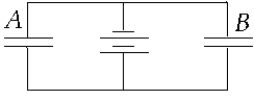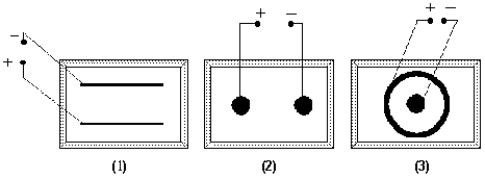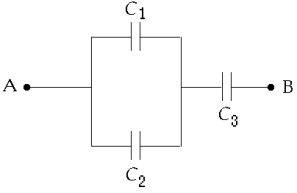A) 0.44 F
B) 2.3 F
C) 3.5 F
D) 5.2 F
E) 12 F
Correct Answer

verified
Correct Answer
verified
Multiple Choice
 Two identical capacitors A and B are connected across a battery, as shown. If mica ( = 5.4) is inserted in B,
Two identical capacitors A and B are connected across a battery, as shown. If mica ( = 5.4) is inserted in B,
A) both capacitors will retain the same charge.
B) B will have the larger charge.
C) A will have the larger charge.
D) the potential difference across B will increase.
E) the potential difference across A will increase.
Correct Answer

verified
Correct Answer
verified
Multiple Choice
A capacitor, C1 = 5.0 F, is charged up to 8 V. It is then connected to a second uncharged capacitor C2 = 2.5 F. The charge on C1 after the system has come to equilibrium is
A) 26.7 C
B) 13.3 C
C) 20.0 C
D) 40.0 C
E) 6.67 C
Correct Answer

verified
Correct Answer
verified
Multiple Choice
You attach a 30-pF capacitor across a 1.5-V battery. How much energy is stored in the capacitor?
A) 3.4 * 10-11 J
B) 4.5 * 10-11 J
C) 6.7 * 10-11 J
D) 3.4 * 10-8 J
E) 4.5 * 10-8 J
Correct Answer

verified
Correct Answer
verified
Multiple Choice
Which of the following statements is false?
A) In the process of charging a capacitor, an electric field is produced between its plates.
B) The work required to charge a capacitor can be thought of as the work required to create the electric field between its plates.
C) The energy density in the space between the plates of a capacitor is directly proportional to the first power of the electric field.
D) The potential difference between the plates of a capacitor is directly proportional to the electric field.
E) All of these are true.
Correct Answer

verified
Correct Answer
verified
Multiple Choice
A parallel-plate capacitor has square plates of side 12 cm and a separation of 6.0 mm. A dielectric slab of constant = 2.0 has the same area as the plates but has a thickness of 3.0 mm. What is the capacitance of this capacitor with the dielectric slab between its plates?
A) 28 pF
B) 21 pF
C) 16 pF
D) 37 pF
E) 53 pF
Correct Answer

verified
Correct Answer
verified
Multiple Choice
The space between the inner wire of radius a = 1 mm of a co-axial cable and the conducting shield of radius b = 8 mm is made of nylon ( = 4.2) . A potential difference of 20 V is maintained between the wire and the shield. The energy stored per meter of the cable is
A) 1.12 nJ/m
B) 22.5 nJ/m
C) 44.9 nJ/m
D) 5.36 nJ/m
E) 2.68 nJ/m
Correct Answer

verified
Correct Answer
verified
Multiple Choice
You charge a 4.0-µF capacitor to 150 V. How much additional energy must you add to charge it to 300 V?
A) 0.60 mJ
B) 0.14 J
C) 18 µJ
D) 0.30 mJ
E) 0.28 J
Correct Answer

verified
Correct Answer
verified
Multiple Choice
If the area of the plates of a parallel plate capacitor is halved and the separation between the plates tripled, while the charge on the capacitor remains constant, then by what factor does the energy stored in the capacitor change?
A) increase by a factor of 2
B) decrease by a factor of 2/3
C) increase by a factor of 6
D) increase by a factor of 3/2
E) decrease by a factor of 1/6
Correct Answer

verified
Correct Answer
verified
Multiple Choice
 In which of these configurations is (are) the electric field(s) uniform?
In which of these configurations is (are) the electric field(s) uniform?
A) 1
B) 2
C) 3
D) 1 and 3
E) 1, 2, and 3
Correct Answer

verified
Correct Answer
verified
Multiple Choice
Use the following figure to answer the next five problems:  -You connect three capacitors as shown in the diagram. C1 = 5.0 F, C2 = 4.0 F, and
C3 = 3.0 F. If you apply 12 V between points A and B, the energy stored in C3 will be approximately
-You connect three capacitors as shown in the diagram. C1 = 5.0 F, C2 = 4.0 F, and
C3 = 3.0 F. If you apply 12 V between points A and B, the energy stored in C3 will be approximately
A) 0.16 mJ
B) 41 J
C) 0.12 mJ
D) 0.41 mJ
E) 16 mF
Correct Answer

verified
Correct Answer
verified
Multiple Choice
The charge on each capacitor in a set of capacitors in parallel is
A) directly proportional to its capacitance.
B) inversely proportional to its capacitance.
C) independent of its capacitance.
D) the same.
E) None of these is correct.
Correct Answer

verified
Correct Answer
verified
Multiple Choice
A coaxial cable consists of a wire of radius 0.30 mm and an outer conducting shell of radius 1.0 mm. Its capacitance per unit length is approximately
A) 17 nF/m
B) 0.11 nF/m
C) 92 pF/m
D) 23 pF/m
E) 46 pF/m
Correct Answer

verified
Correct Answer
verified
Multiple Choice
An electric field, E, is applied to a dielectric. Which of the following statements is true?
A) The electric field within the dielectric is less than E.
B) The dielectric produces an electric field in the opposite direction to E.
C) The molecules in the dielectric become polarized.
D) The electric field will produce a torque on molecules in dielectrics which have permanent dipoles.
E) All the above statements are true.
Correct Answer

verified
Correct Answer
verified
Multiple Choice
The equivalent capacitance of three capacitors in series is
A) the sum of their capacitances.
B) the sum of the reciprocals of their capacitances.
C) always greater than the larger of their capacitances.
D) always less than the smaller of the capacitances.
E) described by none of the above.
Correct Answer

verified
Correct Answer
verified
Multiple Choice
Two large metallic plates are parallel to each other and charged. The distance between the plates is d. The potential difference between the plates is V. The magnitude of the electric field  in the region between the plates and away from the edges is given by
in the region between the plates and away from the edges is given by
A) d/V
B) V2/d
C) dV
D) V/d2
E) None of these is correct.
Correct Answer

verified
Correct Answer
verified
Multiple Choice
A parallel plate capacitor is constructed using two square metal sheets, each of side L = 10 cm. The plates are separated by a distance d = 2 mm and a voltage applied between the plates. The electric field strength within the plates is E = 4000 V/m. The energy stored in the capacitor is
A) 0.71 nJ
B) 1.42 nJ
C) 2.83 nJ
D) 3.67 nJ
E) zero
Correct Answer

verified
Correct Answer
verified
Multiple Choice
 If C1 < C2 < C3 < C4 for the combination of capacitors shown, the equivalent capacitance
If C1 < C2 < C3 < C4 for the combination of capacitors shown, the equivalent capacitance
A) is less than C1.
B) is more than C4.
C) is between C2 and C3.
D) is less than C2.
E) could be any value depending on the applied voltage.
Correct Answer

verified
Correct Answer
verified
Multiple Choice
 If all the four capacitors have equal values of 50 F then calculate the equivalent capacitance of the circuit shown above.
If all the four capacitors have equal values of 50 F then calculate the equivalent capacitance of the circuit shown above.
A) 50 F
B) 30 F
C) 75 F
D) 100 F
E) 83 F
Correct Answer

verified
Correct Answer
verified
Multiple Choice
Two parallel plate air capacitors, each of capacitance X F are in series with a battery of 12-V. If a dielectric with = 3 is inserted between the plates of one of the capacitors, then calculate the change in electrical charge (in Coulombs) that occurs on one of its plates.
A) 9X
B) 3X/4
C) 3X
D) 16X
E) none of the above
Correct Answer

verified
Correct Answer
verified
Showing 41 - 60 of 73
Related Exams